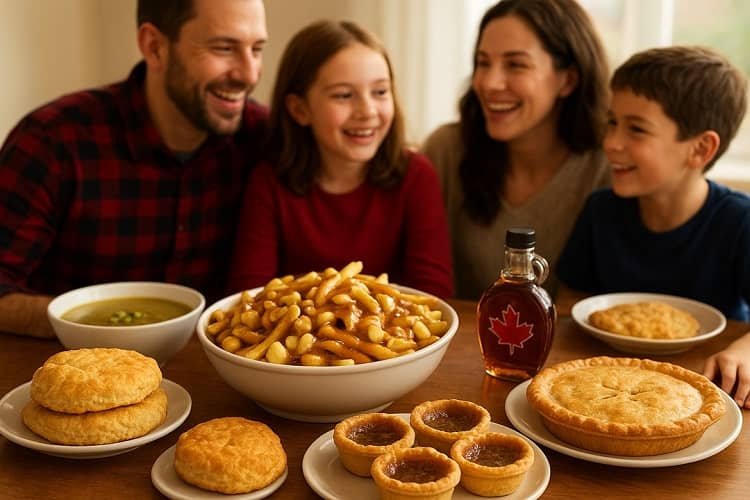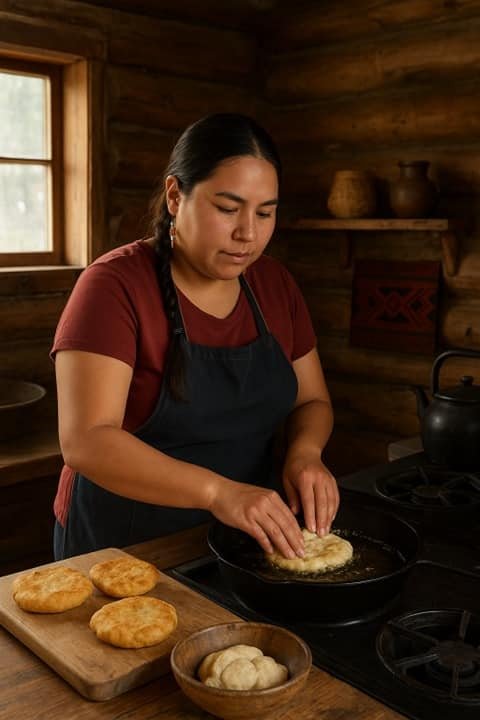
Introduction – What Makes Classic Canadian Cuisine Unique?
Classic Canadian cuisine is not just a menu of dishes — it’s a rich tapestry woven from the threads of Indigenous traditions, French refinement, British heartiness, and the flavors brought by waves of immigrants from all over the world. It reflects the country’s vast landscapes, seasonal shifts, and multicultural heritage.
From maple-sweetened treats to slow-cooked comfort foods, and from Atlantic lobster to Prairie bison, every bite of classic Canadian cuisine tells a story of adaptation, resilience, and community. Whether served in a rustic cabin, a bustling city bistro, or at a festive outdoor market, these dishes connect Canadians — and visitors — to the land and its people.
1. The Origins and Cultural Roots of Classic Canadian Cuisine
Indigenous Culinary Foundations
Long before European settlers set foot in Canada, Indigenous communities had developed a deep relationship with the land and its bounty. Staples such as wild game (moose, deer, bison), freshwater fish (trout, walleye, Arctic char), berries, corn, beans, and squash formed the backbone of their diets. Smoking, drying, and fermenting were essential preservation techniques, leading to iconic foods like:
- Pemmican – dried meat mixed with fat and berries.
- Bannock – a versatile bread that could be baked or fried.
- Smoked Salmon – a delicacy in coastal and river communities.
These early foods remain an integral part of classic Canadian recipes today, often incorporated into modern menus.
French Influence – The Flavors of Quebec
French settlers in the 1600s brought sophisticated cooking techniques, rich dairy-based sauces, and a love for bread and pastries. They adapted traditional European recipes to local ingredients, resulting in dishes like:
- Tourtière – spiced meat pie, perfect for cold winters.
- Pouding Chômeur – a maple syrup-soaked dessert.
- Cretons – pork spread enjoyed at breakfast.
French cuisine’s emphasis on slow cooking, seasoning, and presentation left a lasting imprint on the food culture of Quebec and beyond.
British Contributions – Comfort on a Plate
British settlers contributed hearty, filling meals designed to fuel long workdays and withstand harsh winters. Meat pies, fish and chips, baked beans, and tea-time treats like scones became staples. Over time, these merged with local Canadian produce and flavors, giving birth to dishes such as:
- Peameal Bacon Sandwich – a Toronto breakfast icon.
- Shepherd’s Pie – often using local beef or game.
The Immigrant Mosaic
Post-World War II immigration brought a burst of new flavors into Canadian comfort food traditions. Perogies from Ukrainian settlers, dim sum from Chinese Canadians, Jamaican patties, Indian curries, and Middle Eastern shawarma have all become part of the Canadian food scene — blending seamlessly with traditional dishes to create a unique fusion.
2. Iconic Dishes That Define Classic Canadian Cuisine
2.1 Poutine – The King of Canadian Comfort Food
Golden French fries, fresh cheese curds, and rich, savory gravy — poutine is the epitome of indulgence. Originating in rural Quebec in the 1950s, it has since become a national symbol of Canadian street food.
Gourmet Twists: lobster poutine, butter chicken poutine, and even vegan mushroom gravy versions.
Where to Try:
2.2 Tourtière – French-Canadian Heritage in a Pie
Served traditionally during Christmas Eve and New Year’s Eve, this meat pie features finely minced pork, beef, or wild game seasoned with cinnamon, cloves, and allspice.
2.3 Butter Tarts – A Sweet Slice of Canadian History
Believed to have originated in Ontario in the early 1900s, butter tarts are small pastries with a gooey filling of butter, sugar, and eggs. Some prefer them runny; others like them firm — but all agree they are an essential part of classic Canadian desserts.
2.4 Bannock – The Bread of Survival and Celebration
Adapted by settlers from Indigenous recipes, bannock can be pan-fried, baked, or cooked over an open flame. Today, it’s enjoyed in both traditional and modern forms, often served with soups or stews.
2.5 Maple Syrup – Canada’s Golden Elixir
Canada produces about 75% of the world’s maple syrup, with Quebec leading the way. It’s used not just on pancakes but in candies, glazes, cocktails, and even savory dishes.
Learn more: Maple from Canada Official Site
2.6 Peameal Bacon – Toronto’s Pride
Lean pork loin cured and rolled in cornmeal, then sliced and grilled, peameal bacon is often served in a sandwich and found at Toronto’s St. Lawrence Market.
3. Regional Flavors in Classic Canadian Cuisine
Atlantic Canada – From Sea to Plate
- Lobster Rolls
- Fish Chowder
- Cod Tongues – pan-fried delicacies with crispy edges.
Quebec – Rich and Rustic
- Pouding Chômeur
- Cipaille – a layered meat and potato pie.
- Maple-Glazed Ham
Ontario – Heartland Comfort
- Peameal Bacon Sandwiches
- Butter Tarts
- Wild Rice Dishes
Indo Canadian Food Recipes: A Flavorful Fusion of Cultures
Prairie Provinces – Farm and Field
- Perogies & Kielbasa
- Bison Burgers
- Saskatoon Berry Pie
British Columbia – Pacific Freshness
- Salmon Candy – smoked salmon glazed with maple syrup.
- Nanaimo Bars – chocolate, custard, and coconut layers.
Northern Territories – Arctic Traditions
- Muktuk – whale skin and blubber.
- Arctic Char – grilled or smoked.
4. Seasonal Eating – Nature’s Influence on Classic Canadian Cuisine
Canadian food is deeply seasonal:
- Spring: Maple syrup festivals, fiddleheads, fresh herbs.
- Summer: Corn on the cob, berry picking, seafood boils.
- Fall: Pumpkin pies, apple crisps, wild game.
- Winter: Tourtière, split pea soup, hearty casseroles.
Burger King Breakfast Menu Canada
5. Cooking Classic Canadian Cuisine at Home
Bannock Recipe
Ingredients: 2 cups flour, 2 tsp baking powder, 1 tsp salt, 1 cup water, 2 tbsp oil.
Method: Mix dry ingredients, add water to form dough, pat into a disk, and fry until golden.
Maple-Glazed Salmon Recipe
Ingredients: 4 salmon fillets, 1/3 cup maple syrup, 2 tbsp soy sauce, 1 clove garlic (minced), pepper to taste.
Method: Marinate, then bake at 375°F for 15–20 minutes.
6. Food Festivals Celebrating Classic Canadian Cuisine
- PoutineFest – Ottawa – Website
- Taste of Edmonton – Showcasing regional dishes.
- Elmira Maple Syrup Festival – Ontario
7. Why Classic Canadian Cuisine Deserves Global Recognition
Classic Canadian cuisine embodies the nation’s diversity, history, and connection to the land. It’s humble yet inventive, comforting yet capable of fine dining sophistication. By preserving these recipes and adapting them for new generations, Canadians keep their culinary heritage alive.
FAQs – Classic Canadian Cuisine
Q1: What is the most famous Canadian food?
A: Poutine is globally recognized, but butter tarts, tourtière, and maple syrup are equally iconic.
Q2: Is Canadian food healthy?
A: It varies — many dishes are hearty and indulgent, but healthy versions are possible with fresh local ingredients.
Q3: Which Canadian dessert should I try first?
A: Butter tarts or Nanaimo bars are a great introduction.
Q4: Where can I find official Canadian food resources?
A: Visit Canada.ca and Maple from Canada.
Final Thoughts
Classic Canadian cuisine is a celebration of heritage, geography, and multicultural influences. It’s found in street food stalls, family kitchens, fine dining restaurants, and community festivals. Whether you savor a simple bannock, indulge in poutine, or enjoy a slice of tourtière, you’re tasting centuries of Canadian history in every bite.







